Executive Summary
Since the early days of the financial advisory business, revenue models have evolved to rely less on commissions and more on the recurring income stream generated from the AUM model. The result has been a shift away from an often-one-time sale of a product to an ongoing provision of financial planning and wealth management services. Naturally, AUM-based advisors have had to change how they spend their time, as firms increasingly required advisors to prioritize servicing clients on an ongoing basis (instead of on closing one-time sales of financial products).
Not only have changing business models influenced how advisors spend their time, but as the recently released InvestmentNews Adviser Compensation & Staffing Study reveals, the size of the advisor’s firm also influences how advisors allocate their (limited) hours. As while advisors who own solo practices are more likely to manage all (or most) of the business development and client servicing responsibilities, the larger a firm becomes, the more they rely on support staff to handle client service responsibilities (e.g., paraplanners and service advisors who have little, if any, business development responsibilities). Because with more support staff available to shoulder more of the client-service workload, lead advisors and practicing partners can devote more attention to business development, which ultimately results in higher profit margins. After all, having more affordable support staff manage client servicing is more operationally efficient than having higher-paid advisors deal with these responsibilities. The result is that larger firms tend to have extra capacity (as measured by the number of clients each advisor and support staff can service).
And notwithstanding the rise of the robo-advisor earlier this decade (which stimulated competitive fee compression among financial advisors and caused a dip in advisor productivity), the InvestmentNews study shows that productivity has actually bounced back and now even appears to outpace current trends in increasing revenue! Which suggests that as a firm’s client capacity increases, firms tend to move ‘downmarket’ and target clients that have less assets (versus targeting ultra-high-net-worth clients). As while highly affluent clients may result in more revenue per client, they may also be more labor-intensive for lead and senior advisors (as opposed to associate advisors and staff), which is why larger firms are servicing an increasing number of “mere millionaires”, who can be serviced with scale to a greater degree. Whereas with smaller firms, who don’t have the same ability to leverage economies of scale to successfully shift ‘downmarket’ and pursue smaller clients, the tendency is to maintain focus on larger clients as it has been traditionally in the past.
Ultimately, the key point is that emerging trends show larger advisory firms are shifting away from targeting highly affluent clients, and are instead aiming for smaller clients in the “millionaire sweet spot” – those clients who are still wealthy, but whose needs might not be so complex as to require senior-advisor-level service. And because these clients are generally less labor-intensive and price-sensitive as more highly affluent clients, they are a key factor for the rapid growth seen in many of today’s large firms. Solo advisory firms, on the other hand, lack the resources to implement economies of scale that larger firms are able to establish, and thus the most successful smaller firms flourish by continuing to target larger clients.
The Client Productivity Breakthrough In Scaling Financial Planning Services
For most of our history, financial advisors were in the business of selling either insurance or investment products and lived (or died) by an eat-what-you-kill mentality, where insurance companies and broker-dealers paid financial advisors solely and entirely by the amount of business they brought in. Which made sense when the revenue of the business was largely commission-based because in practice there was no income and revenue to share with the advisor until they brought in the business!
Over the past 20 years, the advisory business has increasingly shifted from a commission-based model to a 1%-of-assets-under-management model (whether through an RIA’s advisory fee, or a 1% commission trail), but the model for compensating advisors has largely remained the same – a carryover of the sales-based eat-what-you-kill approach, where advisors are paid a percentage of the AUM revenue they’ve brought in and now manage on an ongoing basis.
But a key element of the shift from a commission-based to a fee-based recurring-revenue business model is that at some point, an advisory firm owner wakes up on January 1st and realizes that there’s a substantial amount of ongoing recurring revenue coming into the firm that needs to be serviced to ensure it is retained… and that it’s feasible to hire a very good service-minded advisor to take care of those clients, at a far lower cost to the firm because it’s not necessary to pay the service advisor for business development the firm doesn’t necessarily need (and that the service advisor may not necessarily be very good at anyway).
And in fact, the latest Investment News 2019 Compensation & Staffing Study shows that the median Support Advisor in a paraplanner or associate advisor role earns $66,000/year in total compensation, while a Service Advisor who has full responsibility for client relationships (but no business development) has median total compensation of $100,000, and a Lead Financial Advisor (who has at least some business development responsibilities as well) earns $177,955… while Practicing Partners (who have primarily business development responsibility, in addition to clients to manage, and who may have other firm-wide management duties) have a median income of $258,375 (and a total of $440,000/year in income including profit distributions!).
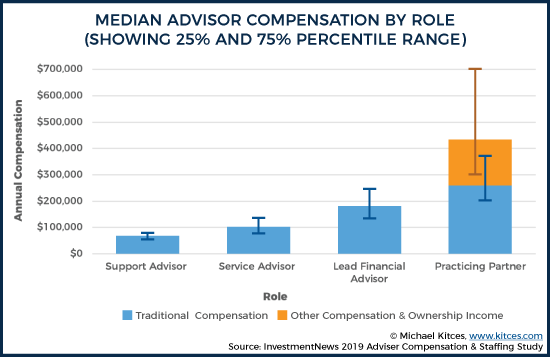
Accordingly, one of the keys to successfully scaling an advisory firm is to ensure that the responsibility for servicing clients is shifted from the more ‘expensive’ partners and lead advisors, and into the hands of servicing and support advisors to the fullest extent possible. Which effectively leverages the time of lead advisors and practicing partners to do more of the (higher paid) business development work (as well as being responsible for the more affluent clients who may demand a more senior advisor to work with).
And in the latest data from the 2019 Compensation & Staffing Study, it turns out that this is exactly what the largest advisory firms are beginning to do… with advisory firms under $10M of revenue averaging 2 support or service advisors for every 3 lead advisors or partners, but larger firms averaging 50% or more of their advisor professionals in service and support roles.
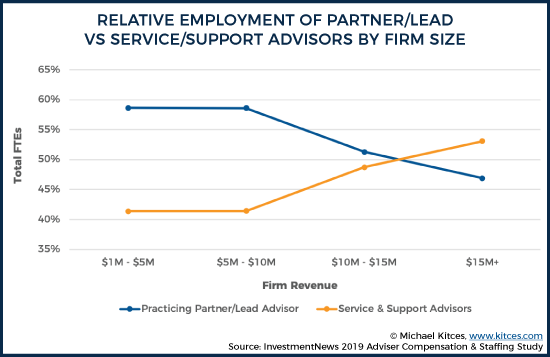
While this may only seem to be a moderate difference in overall staffing, it can have a significant impact on productivity across an entire advisory firm. As found in the recent Kitces Research study on “How Financial Advisors Actually Do Financial Planning”, the average lead financial advisor supports only 73 ongoing clients, but a lead advisor supported by a paraplanner can service 120 clients, which nearly doubles the take-home pay of the advisor (as while client count is nearly doubled for the team, the average cost to service them drops substantially with the lower compensation cost of a paraplanner relative to another lead advisor).
When viewed across the industry at large, this shift to leverage productivity by employing more paraplanners and support advisors is leading to a similar increase in the number of clients per professional in a typical advisory firm, rebounding advisor productivity levels back to where they were in 2013 (before the onslaught of ‘robo-advisor’ platforms forced advisory firms to re-invest into the depth of their advisory teams to better justify their value proposition).
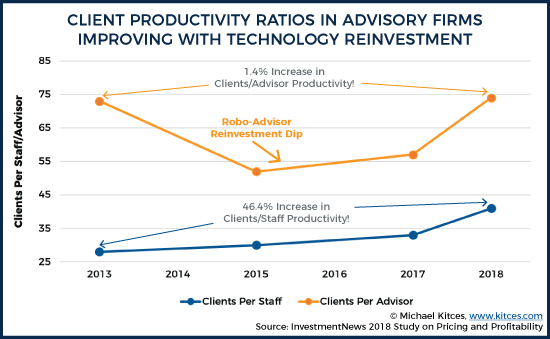
And the end result of this combination of higher client productivity per advisor, coupled with a lower compensation cost to those advisors by better separating the servicing from business development responsibilities (and their associated compensation) is that advisory firms are seeing a reduction in their Direct Expenses associated with attracting and especially retaining clients (i.e., advisor compensation costs), which in turn is leading to an uptick in profit margins, and new record highs in the average income per partner across advisory firms.
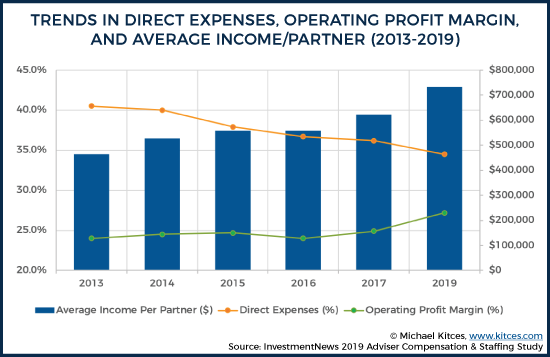
Pricing Rebounds As Advisory Firms Go ‘Downmarket’ To Mere Millionaires And The Mass Affluent
A notable distinction of the trend of rising advisor (and staff) productivity as measured by the number of clients per advisor (and clients per staff member), is that revenue per advisor and per staff member are significantly lagging the growth in client productivity, with revenue per staff only up modestly and revenue per advisor actually down for the past 5 years (since 2014).
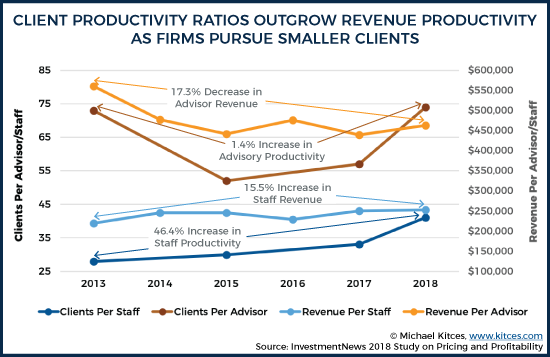
And if productivity in terms of the number of clients per advisor and staff is outpacing the productivity in revenue per advisor and staff … it means that advisory firms appear to be using their size and scale to go ‘downmarket’ and take on clients below their current averages. (In other words, more clients but significantly less revenue per client, such that serving more clients still adds up to less revenue.)
Which is a big deal, because this counters the historical trend of larger advisory firms having better “productivity” than smaller firms (as measured by revenue/professional and revenue/staff), where one of the primary drivers was simply that these larger firms were able to attract more affluent clients who paid bigger fees in the first place.
In other words, larger advisory firms weren’t more ‘productive’ in servicing more clients… they actually tended to service fewer clients per advisor, but the clients were so much more affluent and paid so much more in fees per client that firm productivity still improved with size (though when clients get large enough, their additional service demands begin to reduce advisor productivity, as revenue/professional starts to turn down).
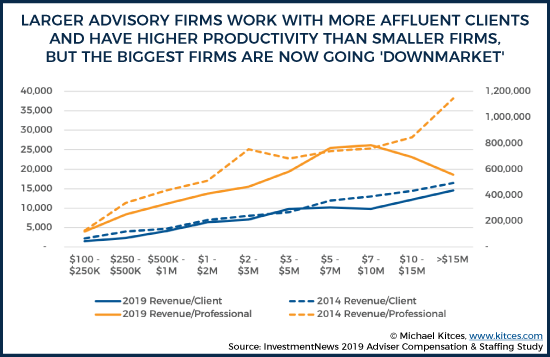
Yet now, for the first time, the latest Investment News study reveals that while for solo firms, the top performers are still the ones that attract the largest clients, for the top-performing large firms (characterized by “Super Ensemble” firms, which include firms with more than $10M in annual revenue), they’re actually succeeding by moving ‘downmarket’ and averaging smaller clients!
As it seems the marketplace is concentrating on the ‘mere millionaire’ who is profitable to serve, able to be serviced with scale, but is less aggressive in negotiating fees and services than big clients (yet still with enough revenue/client to be profitable for large firms, unlike much-smaller clients)!
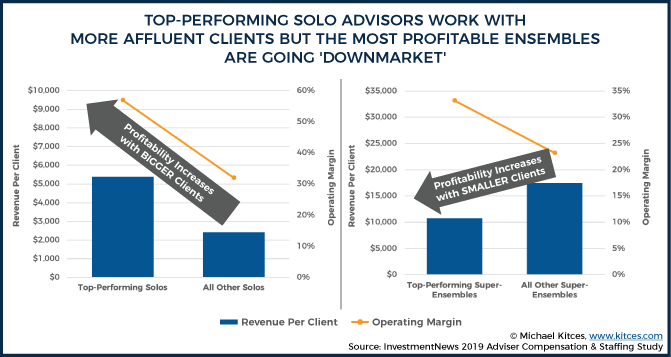
In turn, this shift away from the most pricing-sensitive (and aggressively-price-negotiating) large clients, into the millionaire and mass-affluent clients who historically were the keystones of smaller advisory firms, coupled with a focus on a broader financial planning value proposition, is also leading advisory firms to have more pricing power. Such that the revenue yield for firms jumped from 0.69% to 0.78% this year – over a 10% increase, and is suddenly right back to where it was before the robo-advisor “fee compression” competition ever showed up!
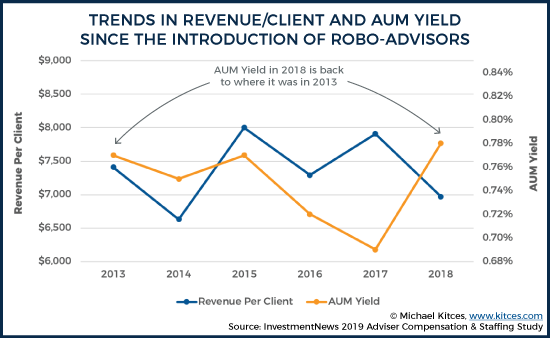
In essence, then, while robo-advisors and the rise of direct-to-consumer technology platforms may have temporarily driven advisory firms more ‘upmarket’ and challenged them to refine their advisor compensation structures and productivity, now that firms have done so, they’re returning to the mass affluent and millionaire segment, with stronger pricing (illustrated by higher AUM yields), better productivity (with more advisor and staff capacity for clients), and better profit margins than before!
Service Advisors Scale Profits But Marketing Scales Growth
As noted earlier, historically the largest firms have been more effective at attracting the most affluent clients. Which may not necessarily be a function of different business development strategies, per se, but simply the credibility of the brand to attract the trust of more affluent clients who have few other ways to distinguish one advisory firm from another.
However, as the largest advisory firms continue to establish their brands, their growth rates are now beginning to accelerate beyond the rest, as the latest Investment News 2019 Compensation & Staffing Study shows that the largest advisory firms are growing faster than any other, and are doing so despite having a significantly larger asset base to grow in the first place.
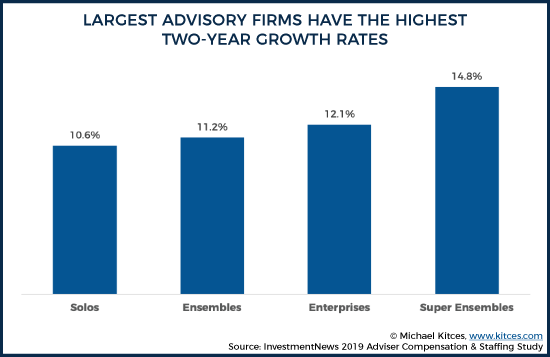
In fact, when viewed in terms of new assets rather than just a raw growth rate, the average Super Ensemble (which already has $10M+ in revenue) added $326M of new assets in 2018, compared to only $114M for Enterprises (with $5M to $10M of revenue), $23M for Ensembles (with $1M+ in revenue), and $6M for solo advisors.
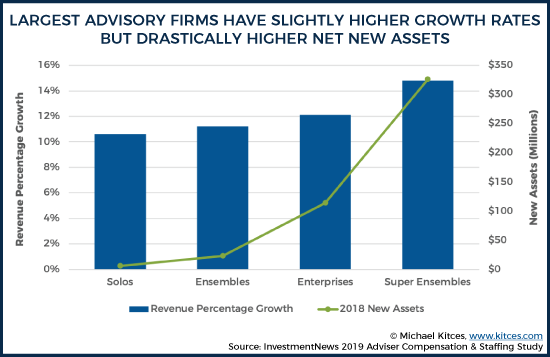
On the other hand, the reality is that mathematically, larger advisory firms do put slightly more towards their marketing than the average firm, at 2.2% of revenue (compared to only 1.6% to 1.9% for smaller firms. And more significantly, larger advisory firms also have significantly more marketing staff infrastructure to deploy those marketing dollars in the first place (which are sizable, as the average Super Ensemble had almost $16M of revenue, resulting in a marketing spend of nearly $350,000/year!).
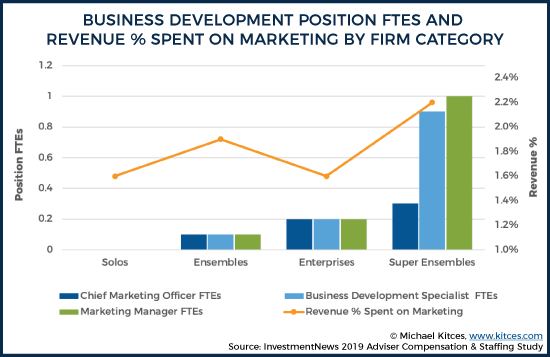
And these effective marketing practices serve to alleviate some of the pressure on lead advisors for business development, allowing them to spend more of their time servicing their most affluent (and often more demanding) clients. While also allowing those large firms to pay less in advisor compensation for “just” the servicing of clients while being less reliant on those lead advisors for (the more-expensive-to-compensate) business development activities.
Still, though, with the largest advisory firms putting the most towards marketing in terms of marketing staffing and outright marketing spending, and generating the highest growth rates (despite having a much-larger denominator to grow in the first place), the data suggest that while advisory firms have historically struggled to gain economies of scale in their advisory services, there are economies of scale in the marketing of those advisory services, as large firms with more capital to deploy towards marketing are getting even better results than the rest. Which in turn will put increasing pressure on smaller and solo advisory firms to niche or specialize to differentiate themselves from large-firm generalists with growing marketing budgets and expanding brand reach!
Ultimately, though, the key trend emerging in the latest Investment News 2019 Compensation & Staffing Study is simply that larger advisory firms appear to be restructuring internally to build themselves for the future, scaling their advisor service teams with non-business-development service advisors (which enhances profitability and productivity with current clients), and then scaling their internal marketing teams to reduce their reliance on advisors to be the drivers of business development in the first place… while leveraging both to expand their target markets and go more ‘downstream’ towards the mere “millionaire sweet spot” they’re increasingly trying to reach!





While I find this analysis interesting and I agree with the main conclusion (that smaller firms will have to work harder to keep up), I have serious reservations about the underlying data.
In the 2017 Investment News Survey (I couldn’t easily find 2019 stats, but I suspect it’s similar), the data was compiled from a mere 353 firms, who self-selected into the survey and whose data was NOT verified, thus failing even the lowest bars for statistically significant results.
This does not however make the data automatically wrong AND to my knowledge no better data exists (at least not publicly).
289 participants in the study.
43 had revenues between $100K – $500K
43 described themselves as solos (uncoincidentally?)
Survey data isn’t perfect but is there a better way??? We’re not publicly traded firms with annual reporting and auditing requirements.
Further, I speculate that:
(1) Survey data bias likely positively skewed vs. industry. Similar to surveying clients for satisfaction … those that ask for feedback have higher satisfaction vs. the industry (per Julia Littlechild).
(2) Survey data likely better for larger, more sophisticated firms with multiple shareholders (more accountability) than solos with generally less sophistication — only accountable to themselves (and the IRS with low audit risk).
Personally, my sophistication has grown significantly in moving from a solo to an ensemble. As a solo, I just needed to know I was taking on a “good client” and had some capacity. Now, I have to be much more intentional in measuring what matters to ensure I’m making prudent business decisions about running, growing, and reinvesting in the business.
I’d suspect you’re more of unicorn in the solo advisor space in regards to #2.
It’s also interesting to read your ‘main conclusion’ from the article. To me it’s not really about that — it’s not even in the title, but we all have our own lense.
I don’t (yet) have a better solution for gather data, but that doesn’t change my skepticism. 🙂
As for getting accurate data from small firms, unless they are filing fraudulent tax returns, we could pull gross off their business return and an effective net off their personal return to get a darn close number. Certainly not perfect, but far better than ‘last year I think I made $$$.”
As for my ‘lens’ on the article, I agree that my assertion of the main point isn’t in the title “Large Advisory Firms Are Scaling Advice For (Better) Profits and (Faster) Growth”, but who other than small firms is Kitces’ references when he says ‘better’?